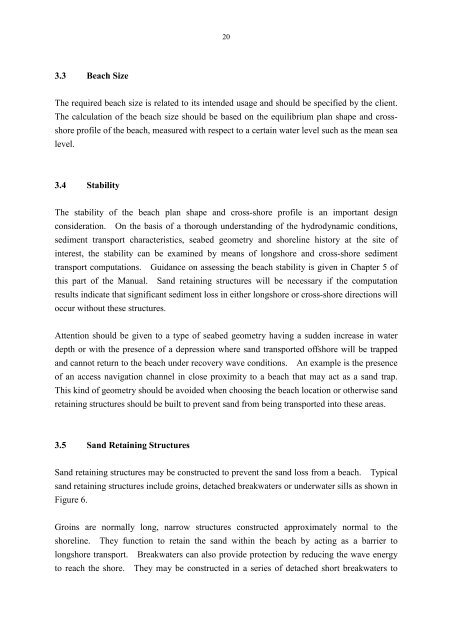PORT WORKS DESIGN MANUAL PART 5 Guide to Design of ...
PORT WORKS DESIGN MANUAL PART 5 Guide to Design of ...
PORT WORKS DESIGN MANUAL PART 5 Guide to Design of ...
Create successful ePaper yourself
Turn your PDF publications into a flip-book with our unique Google optimized e-Paper software.
20<br />
3.3 Beach Size<br />
The required beach size is related <strong>to</strong> its intended usage and should be specified by the client.<br />
The calculation <strong>of</strong> the beach size should be based on the equilibrium plan shape and crossshore<br />
pr<strong>of</strong>ile <strong>of</strong> the beach, measured with respect <strong>to</strong> a certain water level such as the mean sea<br />
level.<br />
3.4 Stability<br />
The stability <strong>of</strong> the beach plan shape and cross-shore pr<strong>of</strong>ile is an important design<br />
consideration. On the basis <strong>of</strong> a thorough understanding <strong>of</strong> the hydrodynamic conditions,<br />
sediment transport characteristics, seabed geometry and shoreline his<strong>to</strong>ry at the site <strong>of</strong><br />
interest, the stability can be examined by means <strong>of</strong> longshore and cross-shore sediment<br />
transport computations. Guidance on assessing the beach stability is given in Chapter 5 <strong>of</strong><br />
this part <strong>of</strong> the Manual. Sand retaining structures will be necessary if the computation<br />
results indicate that significant sediment loss in either longshore or cross-shore directions will<br />
occur without these structures.<br />
Attention should be given <strong>to</strong> a type <strong>of</strong> seabed geometry having a sudden increase in water<br />
depth or with the presence <strong>of</strong> a depression where sand transported <strong>of</strong>fshore will be trapped<br />
and cannot return <strong>to</strong> the beach under recovery wave conditions. An example is the presence<br />
<strong>of</strong> an access navigation channel in close proximity <strong>to</strong> a beach that may act as a sand trap.<br />
This kind <strong>of</strong> geometry should be avoided when choosing the beach location or otherwise sand<br />
retaining structures should be built <strong>to</strong> prevent sand from being transported in<strong>to</strong> these areas.<br />
3.5 Sand Retaining Structures<br />
Sand retaining structures may be constructed <strong>to</strong> prevent the sand loss from a beach. Typical<br />
sand retaining structures include groins, detached breakwaters or underwater sills as shown in<br />
Figure 6.<br />
Groins are normally long, narrow structures constructed approximately normal <strong>to</strong> the<br />
shoreline. They function <strong>to</strong> retain the sand within the beach by acting as a barrier <strong>to</strong><br />
longshore transport. Breakwaters can also provide protection by reducing the wave energy<br />
<strong>to</strong> reach the shore. They may be constructed in a series <strong>of</strong> detached short breakwaters <strong>to</strong>

















